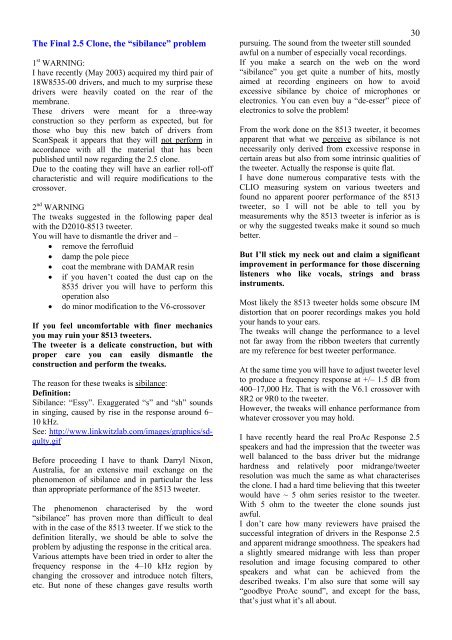The 2.5 clone papers - CCRMA
The 2.5 clone papers - CCRMA
The 2.5 clone papers - CCRMA
You also want an ePaper? Increase the reach of your titles
YUMPU automatically turns print PDFs into web optimized ePapers that Google loves.
<strong>The</strong> Final <strong>2.5</strong> Clone, the “sibilance” problem<br />
1 st WARNING:<br />
I have recently (May 2003) acquired my third pair of<br />
18W8535-00 drivers, and much to my surprise these<br />
drivers were heavily coated on the rear of the<br />
membrane.<br />
<strong>The</strong>se drivers were meant for a three-way<br />
construction so they perform as expected, but for<br />
those who buy this new batch of drivers from<br />
ScanSpeak it appears that they will not perform in<br />
accordance with all the material that has been<br />
published until now regarding the <strong>2.5</strong> <strong>clone</strong>.<br />
Due to the coating they will have an earlier roll-off<br />
characteristic and will require modifications to the<br />
crossover.<br />
2 nd WARNING<br />
<strong>The</strong> tweaks suggested in the following paper deal<br />
with the D2010-8513 tweeter.<br />
You will have to dismantle the driver and –<br />
• remove the ferrofluid<br />
• damp the pole piece<br />
• coat the membrane with DAMAR resin<br />
• if you haven’t coated the dust cap on the<br />
8535 driver you will have to perform this<br />
operation also<br />
• do minor modification to the V6-crossover<br />
If you feel uncomfortable with finer mechanics<br />
you may ruin your 8513 tweeters.<br />
<strong>The</strong> tweeter is a delicate construction, but with<br />
proper care you can easily dismantle the<br />
construction and perform the tweaks.<br />
<strong>The</strong> reason for these tweaks is sibilance:<br />
Definition:<br />
Sibilance: “Essy”. Exaggerated “s” and “sh” sounds<br />
in singing, caused by rise in the response around 6–<br />
10 kHz.<br />
See: http://www.linkwitzlab.com/images/graphics/sdqulty.gif<br />
Before proceeding I have to thank Darryl Nixon,<br />
Australia, for an extensive mail exchange on the<br />
phenomenon of sibilance and in particular the less<br />
than appropriate performance of the 8513 tweeter.<br />
<strong>The</strong> phenomenon characterised by the word<br />
“sibilance” has proven more than difficult to deal<br />
with in the case of the 8513 tweeter. If we stick to the<br />
definition literally, we should be able to solve the<br />
problem by adjusting the response in the critical area.<br />
Various attempts have been tried in order to alter the<br />
frequency response in the 4–10 kHz region by<br />
changing the crossover and introduce notch filters,<br />
etc. But none of these changes gave results worth<br />
30<br />
pursuing. <strong>The</strong> sound from the tweeter still sounded<br />
awful on a number of especially vocal recordings.<br />
If you make a search on the web on the word<br />
“sibilance” you get quite a number of hits, mostly<br />
aimed at recording engineers on how to avoid<br />
excessive sibilance by choice of microphones or<br />
electronics. You can even buy a “de-esser” piece of<br />
electronics to solve the problem!<br />
From the work done on the 8513 tweeter, it becomes<br />
apparent that what we perceive as sibilance is not<br />
necessarily only derived from excessive response in<br />
certain areas but also from some intrinsic qualities of<br />
the tweeter. Actually the response is quite flat.<br />
I have done numerous comparative tests with the<br />
CLIO measuring system on various tweeters and<br />
found no apparent poorer performance of the 8513<br />
tweeter, so I will not be able to tell you by<br />
measurements why the 8513 tweeter is inferior as is<br />
or why the suggested tweaks make it sound so much<br />
better.<br />
But I’ll stick my neck out and claim a significant<br />
improvement in performance for those discerning<br />
listeners who like vocals, strings and brass<br />
instruments.<br />
Most likely the 8513 tweeter holds some obscure IM<br />
distortion that on poorer recordings makes you hold<br />
your hands to your ears.<br />
<strong>The</strong> tweaks will change the performance to a level<br />
not far away from the ribbon tweeters that currently<br />
are my reference for best tweeter performance.<br />
At the same time you will have to adjust tweeter level<br />
to produce a frequency response at +/– 1.5 dB from<br />
400–17,000 Hz. That is with the V6.1 crossover with<br />
8R2 or 9R0 to the tweeter.<br />
However, the tweaks will enhance performance from<br />
whatever crossover you may hold.<br />
I have recently heard the real ProAc Response <strong>2.5</strong><br />
speakers and had the impression that the tweeter was<br />
well balanced to the bass driver but the midrange<br />
hardness and relatively poor midrange/tweeter<br />
resolution was much the same as what characterises<br />
the <strong>clone</strong>. I had a hard time believing that this tweeter<br />
would have ~ 5 ohm series resistor to the tweeter.<br />
With 5 ohm to the tweeter the <strong>clone</strong> sounds just<br />
awful.<br />
I don’t care how many reviewers have praised the<br />
successful integration of drivers in the Response <strong>2.5</strong><br />
and apparent midrange smoothness. <strong>The</strong> speakers had<br />
a slightly smeared midrange with less than proper<br />
resolution and image focusing compared to other<br />
speakers and what can be achieved from the<br />
described tweaks. I’m also sure that some will say<br />
“goodbye ProAc sound”, and except for the bass,<br />
that’s just what it’s all about.

















